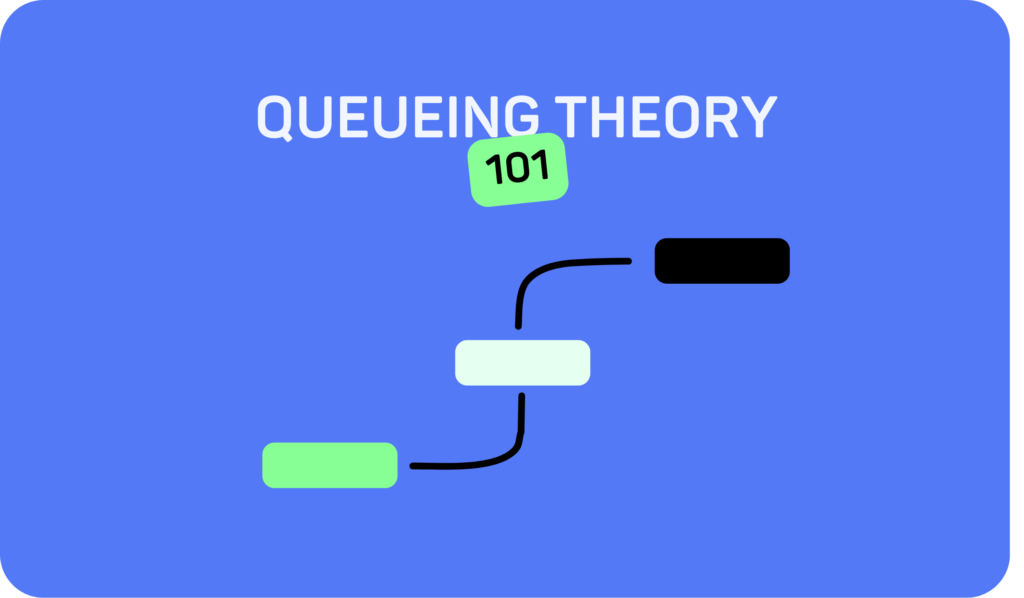What is Queueing Theory? From Basic Concepts To Best Practices

In our everyday lives, we frequently encounter queues – whether waiting for our morning coffee, standing in line at the grocery store, or navigating traffic. But what if there was a scientific approach to understanding and managing these queues? The answer is queueing theory. So, what is queueing theory? At its core, queueing theory is the mathematical study of waiting lines or queues. It provides a framework for analyzing various systems where congestion and waiting times occur, allowing us to optimize and improve efficiency.
This article will decode queueing theory, exploring its key principles, real-world applications, and the insights it offers for managing queues in various domains. Whether you’re a student, a professional, or simply curious about the science behind waiting lines, this guide will provide you with a comprehensive understanding of queueing theory, arrival pattern, Its basic concepts, and its significance in our daily lives.
What Is Queueing Theory and What are Its Basic Concepts
Queueing theory is a mathematical study of waiting lines, or queues. This theory is essential for understanding and optimizing the performance of various systems that involve waiting times, from telecommunications to retail to transportation.
Queueing theory involves the analysis of queues formed by entities waiting for service. It provides tools to model and analyze systems, predict their behavior, and improve their performance. This theory is used in various fields such as Queue Management Systems, telecommunications, healthcare, manufacturing, and service industries.
Basic Concepts of Queueing Theory
Queueing theory provides a foundation for analyzing and improving systems where waiting is involved. Here are some of the core concepts:
a. Arrival Rate (λ\lambdaλ): The rate at which entities arrive at the queue. For example, in a bank, it could be the number of customers arriving per hour.
b. Service Rate (μ\muμ): The rate at which entities are served. This might be the number of customers a teller can serve in an hour.
c. Queue Discipline: The order in which entities are served. The most common discipline is First In, First Out (FIFO), where the first entity to arrive is the first to be served.
d. Utilization (ρ\rhoρ): The ratio of the arrival rate to the service rate (ρ=λ/μ\rho = \lambda / \muρ=λ/μ). This measure indicates how busy the system is. A utilization of 1 means the system is fully utilized.
Arrival Pattern in Queueing Theory
The arrival pattern of entities into a system significantly impacts queue behavior. Understanding this pattern helps in designing better queue management systems.
a. Poisson Process: This is the most common arrival pattern in queueing theory. It assumes that arrivals are random but have a consistent average rate. For instance, customers arriving at a service counter might follow a Poisson distribution, meaning the time between arrivals is exponential and the arrivals are memoryless (the probability of an arrival is independent of previous arrivals).
b. Non-Poisson Arrivals: These include deterministic arrivals, where entities arrive at regular intervals, and batch arrivals, where groups of entities arrive simultaneously. For example, a scheduled bus service has deterministic arrivals, whereas a tour group arriving at a museum represents batch arrivals.
Types of Queues
Understanding the different types of queues helps in selecting the appropriate model for a given scenario.
a. Single-Server Queue: In this type, one server processes all entities in the queue. For example, a single checkout counter in a store.
b. Multi-Server Queue: Multiple servers process entities simultaneously, like multiple checkout counters in a supermarket.
c. Infinite Queue: There is no limit to the number of entities that can wait in the queue. This is often an idealization used in theoretical models.
d. Finite Queue: There is a limit to the number of entities in the queue. Once this limit is reached, new arrivals are either turned away or queued elsewhere. An example is a parking lot with a fixed number of spaces.
Performance Metrics in Queueing Theory
Performance metrics are crucial for evaluating the effectiveness of a queueing system. These metrics help in identifying areas of improvement and ensuring optimal performance.
a. Average Wait Time: This is the average time an entity spends waiting in the queue before being served. Reducing this time is often a primary goal in queue management.
b. Average Queue Length: The average number of entities in the queue at any given time. Shorter queues generally lead to higher customer satisfaction.
c. System Throughput: The rate at which entities are served by the system. Higher throughput indicates a more efficient system.
d. Probability of Delay: The likelihood that an arriving entity will have to wait for service. Lower probabilities of delay are preferred as they indicate a smoother and quicker service.
Key Queueing Theory Equations
The key equations in queueing theory help us understand relationships between various parameters such as the arrival rate (λ\lambdaλ), service rate (μ\muμ), and the average number of items in the system (L). For instance, Little’s Law is a fundamental formula that links the average number of items in a queue to the arrival rate and the average waiting time. By applying these equations, businesses can design more efficient queue management systems, leading to reduced waiting times and improved customer satisfaction.
| Equation | Description |
|---|---|
| L = λW | Little’s Law: Relates the average number of items in the system (L) to the arrival rate (λ) and the average time an item spends in the system (W). |
| Lq = λWq | Average number of items in the queue (Lq) is the product of the arrival rate (λ) and the average time an item spends waiting in the queue (Wq). |
| W = Wq + 1/μ | The average time an item spends in the system (W) is the sum of the average waiting time in the queue (Wq) and the average service time (1/μ). |
| ρ = λ/μ | Utilization factor: The ratio of the arrival rate (λ) to the service rate (μ). This measures how busy the system is. |
| P0 = 1 – ρ | The probability that there are zero items in the system (i.e., the system is empty). |
| Pn = (1 – ρ)ρn | The probability that there are n items in the system. |
Applications of Queueing Theory in QueueHub Queue Management System
QueueHub leverages queueing theory to provide superior queue management solutions. Here are some applications:
a. Customer Flow Management: By predicting peak times, QueueHub helps businesses manage customer flow more effectively, ensuring that sufficient resources are available to handle the increased demand.
b. Resource Allocation: QueueHub uses queueing theory to allocate resources dynamically. For example, adding more servers during peak times to reduce wait times.
c. Queue Simulation: QueueHub allows businesses to model different scenarios and test various strategies to find the most effective queue management approach.
Importance of Queueing Theory in QueueHub
QueueHub utilizes queueing theory to optimize queue management. By understanding the principles of queueing theory, QueueHub can design systems that minimize wait times, improve service efficiency, and enhance customer satisfaction. This understanding helps in developing features that predict busy periods, allocate resources effectively, and streamline operations.
Queueing Models
Different queueing models are used based on the specific requirements of the system being analyzed. Some of the common models include:
a. M/M/1 Queue: This model represents a single-server queue with Poisson arrivals and exponential service times. It’s a basic and widely used model in queueing theory.
b. M/M/c Queue: This represents a multi-server queue with Poisson arrivals and exponential service times. It’s used when there are multiple servers available to process entities.
c. M/G/1 Queue: This model represents a single-server queue with Poisson arrivals and a general service time distribution. It is more flexible as it does not assume exponential service times.
Real-World Examples of Queueing Theory
Queueing theory is applied in various real-world scenarios to improve efficiency and customer satisfaction. Here are some examples:
a. Call Centers: Queueing theory helps manage call wait times and agent availability, ensuring that customer calls are answered promptly and efficiently.
b. Hospitals: In healthcare, queueing theory optimizes patient flow and reduces wait times in emergency departments, improving overall patient care.
c. البنوك: Banks use queueing theory to manage teller availability and customer wait times, ensuring smooth and efficient service during peak hours.
Advantages of QueueHub Queue Management System
Implementing queueing theory in QueueHub offers several benefits:
a. Enhanced Customer Satisfaction: By reducing wait times, QueueHub improves customer experiences, leading to higher satisfaction and loyalty.
b. Improved Efficiency: QueueHub’s queue management solutions ensure better resource allocation and operational efficiency.
c. Predictive Analytics: QueueHub uses queueing theory to forecast busy periods and prepare accordingly, ensuring smooth operations during peak times.
Challenges in Implementing Queueing Theory
While queueing theory offers many benefits, there are also challenges in its implementation:
a. Data Accuracy: Ensuring the data used for modeling is accurate and up-to-date is crucial for effective queue management.
b. Complexity of Models: Some queueing models can be complex and difficult to implement, requiring specialized knowledge and tools.
c. Variability in Arrival and Service Rates: Managing fluctuations in arrival and service rates can be challenging, requiring dynamic and flexible queue management solutions.
Tools and Techniques in Queueing Theory
Various tools and techniques are used in queueing theory to analyze and improve queueing systems:
a. Little’s Law: A fundamental theorem that relates the average number of entities in a system (L) to the average arrival rate (λ\lambdaλ) and the average time an entity spends in the system (W): L=λWL = \lambda WL=λW. This law is used to quickly estimate key performance metrics.
b. Simulation Software: Tools like Arena, Simul8, and AnyLogic allow for the modeling and analysis of complex queueing systems. These tools help businesses visualize different scenarios and make informed decisions.
c. Analytical Methods: Mathematical techniques, such as solving differential equations and using Markov chains, are used to analyze queueing models and predict their behavior.
Future Trends in إدارة الطوابير
The field of queueing theory continues to evolve, and QueueHub stays at the forefront of these advancements:
a. AI and Machine Learning: Integrating AI to predict customer behavior and optimize queues in real-time. Machine learning algorithms can analyze historical data and provide accurate predictions for future demand.
b. IoT and Smart Queues: Using IoT devices to monitor and manage queues dynamically. For example, sensors can detect the number of people in a queue and automatically adjust resources.
c. Enhanced Data Analytics: Leveraging big data to improve accuracy in queue predictions and resource allocation. Advanced analytics tools can provide deeper insights into queueing patterns and help businesses optimize their operations.
Frequently Asked Questions
What is queueing theory?
Queueing theory is the mathematical study of waiting lines or queues, used to understand and optimize the performance of systems involving waiting times.
How does QueueHub utilize queueing theory?
QueueHub uses queueing theory to design systems that minimize wait times, improve service efficiency, and enhance customer satisfaction by predicting busy periods and allocating resources effectively.
What is an arrival pattern in queueing theory?
An arrival pattern describes how entities arrive at the queue, with the Poisson process being the most common pattern, assuming random arrivals with a consistent average rate.
What are the basic concepts of queueing theory?
Basic concepts include the arrival rate (λ\lambdaλ), service rate (μ\muμ), queue discipline, and utilization (ρ\rhoρ).
What are some real-world applications of queueing theory?
Queueing theory is applied in call centers, hospitals, banks, and retail stores to manage wait times and resource allocation effectively.
What are the future trends in queueing theory?
Future trends include the integration of AI and machine learning, the use of IoT for smart queues, and enhanced data analytics for more accurate queue predictions and resource management.
Conclusion
Understanding what is queueing theory and its applications is vital for any organization that manages waiting lines. For QueueHub, leveraging queueing theory ensures that systems are optimized for efficiency and customer satisfaction.
By implementing the principles of queueing theory, QueueHub can offer unparalleled queue management solutions, maintaining its position as the best Queue Management System with many features.




